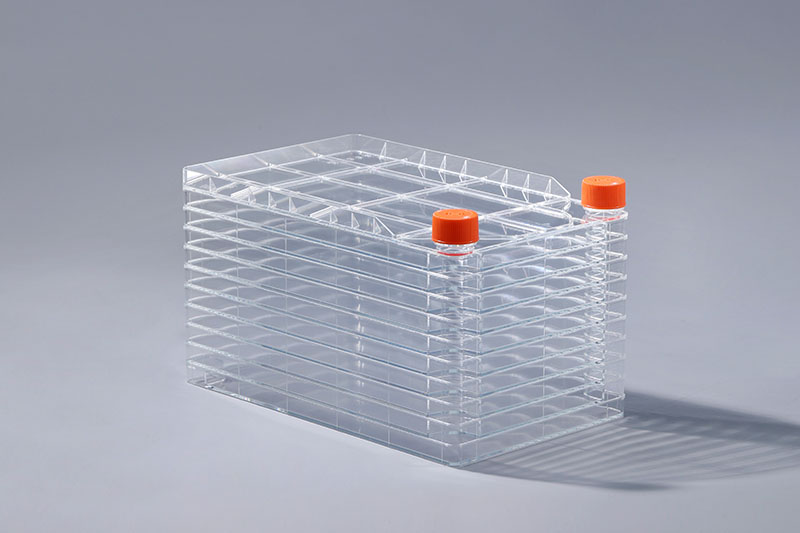S neustálymi inováciami a rýchlym rozvojom biotechnológií zaznamenali regeneratívna medicína a bunková terapia explozívny rast a rozsiahla technológia bunkových kultúr naďalej dozrieva. Spomedzi nich je Okrem toho môže použitie trepačky zohrávať úlohu pri prenose hmoty, čo prispieva k odberu vzoriek a určovaniu rôznych parametrov. Preto pri použití bunkových tovární na kultiváciu vo veľkom meradle sa všeobecne používa trepačka na zlepšenie účinnosti kultivácie a zabezpečenie hladkého postupu bunkovej kultúry. bežne používaným spotrebným materiálom vo veľkom meradle bunkových kultúr a tento spôsob kultivácie buniek vo všeobecnosti vyžaduje pomoc trepačky. zahŕňajú CHO, Vero, MRC-5, 2BS, 293T, L929 a ľudské diploidné bunky. Tieto bunky sa používajú najmä v erytropoetíne, prípravku monoklonálnych protilátok, výrobe vakcín a iných produktoch. Kultivácia živočíšnych buniek vo veľkom in vitro vyžaduje masovú produkciu s vysokou hustotou v nádobách na bunkové kultúry za podmienok umelo nastavenej teploty, vlhkosti, pH a rozpusteného kyslíka. vlastnosti šetrenia miesta, znižovania vstupnej práce a vyhýbania sa znečisťovaniu a sú postupne uprednostňované vedecko-výskumnými inštitúciami a farmaceutickými spoločnosťami. Vo všeobecnosti si výroba vo veľkom meradle v bunkových továrňach vyžaduje pomoc trepačky. Je to preto, že vo veľkoplošnej kultúre je veľa vrstiev nádob. Pomocou trepačky možno realizovať automatizáciu operácií, ako je kŕmenie kvapalinou, miešanie buniek a trávenie a odtok počas kultivácie. a vysoká účinnosť, znižuje chyby spôsobené ťažkými ručnými operáciami a ľudským faktorom.
At present, common large-scale cultured animal cells include CHO, Vero, MRC-5, 2BS, 293T, L929 and human diploid cells. These cells are mainly used in erythropoietin, monoclonal antibody preparation, vaccine production and other products. The large-scale culture of animal cells in vitro requires high-density mass production in cell culture containers under the conditions of artificially set temperature, humidity, pH and dissolved oxygen.
Among many large-scale culture methods, cell factories have the characteristics of saving space, reducing labor input, and avoiding pollution, and are gradually favored by scientific research institutions and pharmaceutical companies. Generally, large-scale production in cell factories requires the help of a shaker. This is because there are many layers of containers in large-scale culture. Using a shaker can realize the automation of operations such as liquid feeding, cell mixing, and digestion and effluent during culture. and high efficiency, reducing errors caused by heavy manual operations and human factors.
In addition, the use of a shaker can play a role in mass transfer, which is conducive to the sampling and determination of different parameters. Therefore, when using cell factories for large-scale culture, a shaker is generally used to improve the culture efficiency and ensure the smooth progress of cell culture.
The FAI climbed 5.9 percent year-on-year in the first 11 months of 2018, quickening from the 5.7-percent growth in Jan-Oct, the National Bureau of Statistics (NBS) said Friday in an online statement.
The key indicator of investment, dubbed a major growth driver, hit the bottom in August and has since started to rebound steadily.
In the face of emerging economic challenges home and abroad, China has stepped up efforts to stabilize investment, in particular rolling out measures to motivate private investors and channel funds into infrastructure.
Friday's data showed private investment, accounting for more than 60 percent of the total FAI, expanded by a brisk 8.7 percent.
NBS spokesperson Mao Shengyong said funds into weak economic links registered rapid increases as investment in environmental protection and agriculture jumped 42 percent and 12.5 percent respectively, much faster than the average.
In breakdown, investment in high-tech and equipment manufacturing remained vigorous with 16.1-percent and 11.6-percent increases respectively in the first 11 months. Infrastructure investment gained 3.7 percent, staying flat. Investment in property development rose 9.7 percent, also unchanged.
 English
English



















































